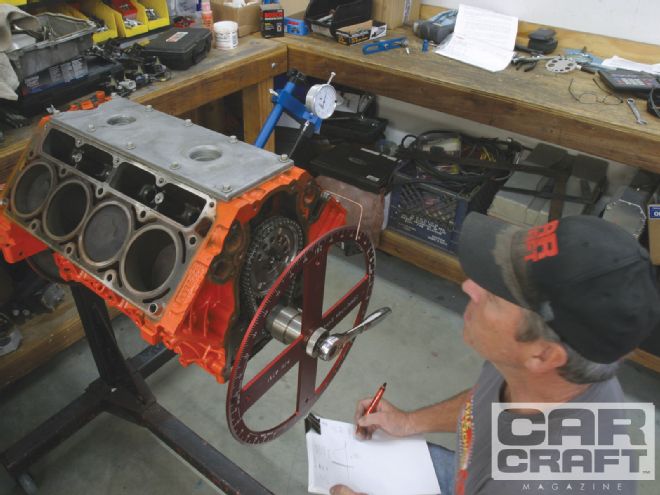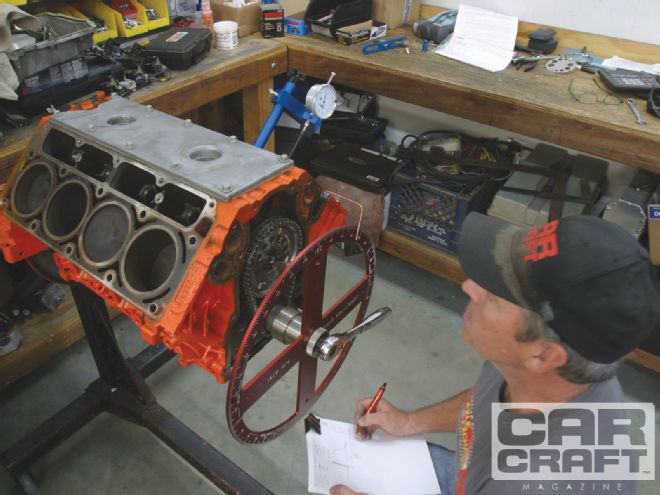
Horsepower has never been easier to make, and the motor leading the charge is the new LS engine. What we've learned is that just the simple addition of a more aggressive camshaft can easily add 50 to 100 hp to an otherwise stock LS engine. This applies to virtually all the LS series of engines. And if you're going to the effort of bolting in a camshaft, you might as well degree it to ensure it will be timed properly. If you've never degreed a camshaft, now is a great time to learn. And if you've been through it a few times before, much of this will be very familiar, even if we're doing it on a new engine. Let's get started.
 With a few simple tools and a little bit of camshaft knowledge, you can degree a camshaft in a matter of minutes.
With a few simple tools and a little bit of camshaft knowledge, you can degree a camshaft in a matter of minutes.
Details There are some interesting details about cam timing that may come in handy when you begin the engine-building process. The lobe-separation angle (sometimes called the lobe-center angle) is the distance in cam degrees between the intake and exhaust lobe centerlines. Decreasing the angle (106 versus 114 degrees) between these lobe centerlines increases the amount of overlap. Generally, with longer-duration camshafts, a wider lobe-separation angle is needed to maintain a given amount of overlap. If duration is increased and lobe-separation angle is tightened, it drastically increases the amount of overlap. Conversely, a wide lobe-separation angle used in stock LS engines can approach 116 to 118 degrees or more, reduce the overlap, and create a very smooth idle.
As an example, the cam we used in the degree process has a lobe-separation angle of 113 degrees, yet the intake centerline is listed as 109 degrees ATDC. If a camshaft is ground with no advance, the intake centerline and lobe-separation angle will be the same. With the Comp cam used in our story, the intake centerline is actually 4 degrees advanced in relation to TDC. Most cam manufacturers dial a certain amount of advance into cams intended for street use to improve low-speed throttle response with earlier opening and closing points. Since the camshaft is already advanced before it finds its way into the engine, degreeing the cam is important to verify the valve opening and closing points and also points out why advancing the cam further may not be a good idea.
The intake centerline method is also not the only way to degree your camshaft. Among the intake and exhaust valve opening and closing points, intake closing is by far the most important. Advancing or retarding the camshaft is really all about positioning the intake closing point. Since most cam cards list intake and exhaust opening and closing points at 0.050-inch tappet lift, a quick check would be to compare the cam's intake closing point at 0.050 with the data on the cam card. If the numbers agree, the cam is installed properly, or you can use the referenced intake closing point to either advance or retard the cam.
PARTS LIST DESCRIPTION PN SOURCE PRICE Comp Cams LS cam degree kit 4942 Summit Racing $187.95 Comp LS timing set 7106 Summit Racing 126.95 Comp Cams camshaft 54-469-11 Summit Racing 396.95 Comp 16-inch degree wheel 4791 Summit Racing 187.95 Comp 9-inch degree wheel 4790 Summit Racing 16.95 Comp LS crankshaft socket 4914 Summit Racing 47.95 Comp head-off TDC stop, universal 4933 Summit Racing 10.95 Comp 0-1-inch dial indicator 4909 Summit Racing 31.95 Comp heads-off degree fixture 4901 Summit Racing 75.95 Comp 5-inch indicator extension 4912 Summit Racing 9.25 ARP cam bolts 134-1003 Summit Racing 6.15